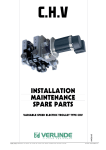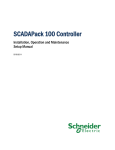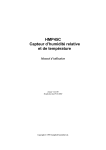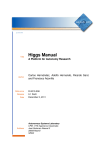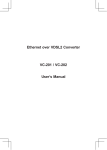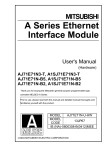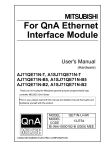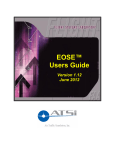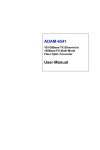Download Understanding Calibration Part 1 - Aircraft Electronics Association
Transcript
INDUSTRY PART I: Understanding Calibration Regular Calibration and Repairs Necessary for Accurate Operations b y W a l t e r S h a w l e e 2 Editor’s Note: This is Part I of a two-part series exploring calibration of equipment. Part I of the series focuses on the necessity of calibration and repairs for accurate operations. E Illustration by Larry Stewart very electronic device ever designed has issues of component drift and change, as well as the usual wear-out, damage and failure modes. To avoid these problems impacting avionics work, regular calibration and repairs are necessary to ensure accurate operation. In addition to regular calibration cycles, it is important to develop a solid daily self-check routine to validate equipment before beginning work. This daily check strategy is one of the best contributions of ISO 9000 techniques to the avionics world, and it can truly help an operation if implemented wisely. Fortunately, an avionics shop does 62 avionics news • september 2008 not need to embrace the full nightmare of ISO 9000 certification to get the benefits of a quick daily performance verification. To learn more about ISO 9000 techniques, visit the International Organization for Standardization at www.iso.org. Simple Daily Checks A simple check for using any DMM (digital multi-meter) is to short the leads and check for zero ohms (this confirms the leads are good and considerable circuitry is working). Then, check a 9V battery on possible DC voltage scales and a 1K ohm precision resistor on possible scales. Use the 9V battery and resistor in series to do a simple 9mA current test, and the 115VAC line voltage for an AC voltage test. If values are good (keep a log and use the same battery and resistor), it is good to go for the day with about 95 percent confidence. A known good current source to add a better current test (a current limited power supply is ideal) allows a more precise check if current is an important daily parameter. When a value out of the expected range is seen, crosscheck the source with a second instrument. If the source is good, note the problem, then send the suspect DMM for calibration or repair. This prevents the day’s work being performed with a bad instrument. If your meter shows the “Low Battery” or similar weak battery message, immediately replace the internal battery and re-check. Normally, calibration is not affected by this battery change, but operational accuracy can be affected. More complex equipment can be checked together (counter to signal generator, signal generator to scope, etc.) with a simple test or reference setting to ensure operation before daily work begins. Getting into this habit prevents serious problems with the day’s work and ensures a higher quality of general operations. It also quickly catches equipment defects before they can influence any external avionics system work. Understanding Accuracy, Precision, Resolution, Uncertainty “Accuracy” is a measure of how close you are to a known standard reference; it is generally expressed in terms of percent or some unit value tolerance. “Precision” is not the same; it is the degree of resolution possible with an instrument or device. An instrument can be precise without being accurate, and vice-versa, as they are measures of different qualities. For example, a ruler with divisions only every quarter of an inch is not very precise, but it can be very accurate. A digital multi-meter with 4 ½ digits of resolution has considerable precision, but in fact, might have terrible accuracy in terms of the measured value, rendering its “precision” irrelevant. For a good explanation of the difference between these two terms, visit http://en.wikipedia.org/wiki/Accuracy. The “resolution” of a measurement is a reflection of how finely the distinct values will be displayed; it is the numerical expression of the device’s precision. For example, a simple digital meter reading 0-1.00VDC has a resolution of 1 percent or one part per 100. If the display is 1.000VDC, the resolution increases to 0.1 percent or one part per 1,000, but it implies nothing about real accuracy, only the granularity of the measurement. Because all digital measurements implicitly have a quantization error (A-to-D conversion uncertainty) of at CALIBRATION Q&A Q: How accurate is my equipment? A: Some instruments can be inaccurate by design. Consider this: A 3 ½ DMM implies tit can resolve one part in 1,999; or, if thought of in terms of 1V, one part in a 1,000 or 0.001, which is 0.1 percent of full scale expressed as 1 volt. An instrument can be inaccurate in an absolute sense and still be “within calibration.” For example, a meter with a full-scale accuracy of 0.3 percent on DC, and a +/- 1 digit uncertainty is still “within cal” if it reads 1.004 or 0.996 on the 1 volt DC scale. This spread of values could be seen within your lab (a spread of .008V) between different instruments, and everything still be “within cal” for a spec of 0.3 pecent and a 1 digit uncertainty. If the scale is actually 3.2V FS, the error at 1 volt DC can be 1.010 and still be at the limit of calibration, although the error is 1 percent of the displayed value. least plus or minus one significant figure, it means those same displays have an implicit error of at least 1 percent and 0.1 percent on top of any basic accuracy problems. Accuracy is a measurement of how closely the displayed value is to the known real value. Unfortunately, it can be expressed in confusing ways. From a quantum perspective, it can never be any closer than the basic resolution, but it can be far worse. Common practice is to specify the error in terms of the full-scale value, such as 0.1 percent FS. However, this can mean any measured value less than full scale can have a much larger absolute error than expected because the error is not expressed in terms of the value displayed, but rather in terms of the full-scale range. It is not uncommon for low-cost 3.5 or 4.5 imported DMMs to have serious accuracy problems on AC measurements — 0.5 percent to 1.5 percent FS is common, and errors as large as 0.5 percent FS on DC and 1 to 2 percent FS for current. This error effectively makes them two digital meters from a practical perspective. These meters also can have huge floor specifications on top of the basic “accuracy,” such as +/- 5 digits — which is a complicated way of saying they are just not very accurate. Continued on following page Illustration by Larry Stewart Installers should perform “pullchecks” on crimped terminals and lugs (no wire should come out) with their crimping tools to ensure they are not too worn and/or use a size gauge to confirm their continuity test gear and any extension cables are fully functional. These quick daily checks can save a world of trouble in an installation. avionics news • september 2008 63 CALIBRATION Continued from page 63 Read all the specs carefully before buying any test equipment, and be certain you really understand its capabilities. Many digits do not ensure accuracy, only more resolution. Keep in mind, during calibration, you have to deal not only with the errors of the item being calibrating, but also the errors of your own reference standards, as well as how they were calibrated and the physical connections, temperature and other factors involved in making the measurement. These collective factors are referred to as the “uncertainty” of a measurement. Calibration is really about the reduction and control of errors and uncertainty, not their complete elimination, which generally is not possible. Uncertainties in calibration measurements basically are composed of two types of variables. Type A data is generally composed of statistical variables, such as the ability to reproduce the results and to repeat them. Type B data is usually the assigned statistical probability distribution from specifications such as accuracy, resolution and transferred measurement uncertainties. Type A and Type B are combined for the total uncertainty of the measurement. An example of how a cal lab could specify its best measurement capability as an uncertainty for 10 volts DC is: 10V ± 12 μV per Volt ± 0.5 μV. This represents the best effort possible with its equipment and techniques, and will inevitably be further degraded by the inaccuracy of your own specific equipment during the transfer calibration. How the Calibration Industry Functions Many shifts have occurred in the calibration industry during the past few years — some driven by ISO procedures, some by profit issues, and some 64 avionics news • september 2008 CALIBRATION Q&A Q: Can I calibrate items internally? A: This is a complex issue. If you have externally validated suitable standards still in valid calibration status and if you have established valid cal procedures based on the manufacturer’s service manual with tolerances for them, then yes, you can internally calibrate items of lesser accuracy. The required accuracy of your “standard” typically is four times better than what you wish to calibrate; 10 times is preferred. Many shops own nothing of good enough quality transfer standard to do other lesser items; therefore, they find external calibration is the best and most cost-effective answer. However, investing in a few good quality instruments can permit you to reliably and internally cal many lesser items (counters, digital multi-meters, power supplies). Basically, any 3 ½ digital multi-meter can be a high-quality standard for calibrating a power supply, which typically has only a 2 to 3 percent tolerance.Good practice dictates anything used as an internal “cal standard” should be used in this function primarily at the beginning of its cal cycle, not at the end, because accuracy can be expected to degrade by that time. In addition, the FAA has been insisting that “standards” be segregated from daily use items (to preserve their integrity); so, keep that in mind in your shop planning. Most shops have no way to calibrate complex nav system generators, spectrum analyzers, low-level frequency generators or their own primary or transfer standards; therefore, external calibration is clearly required in these cases. Be certain, however, the cal facility you use actually can calibrate all functions of your nav equipment. Because of the obscure nature of many avionics items, this is not a given, even at high-end calibration facilities. by staff and equipment shortages. Today, it is important to understand exactly what you are asking for when sending equipment out for calibration, and to understand how it will impact prices and what you will receive back when the “calibration” work is completed. In the avionics world, the implicit understanding when you have a radio in for service or certification is to return it in as close to factory-original, accurate condition as possible — the customer reasonably expects nothing less. It is not common practice in the avionics industry to return radios (especially nav gear) with errors at the extreme specification limits and for you to do nothing other than check and return the radio without adjustment. And yet, this routinely happens in the calibration world unless you fully understand the process. It is also possible to have equipment “fail” calibration and be returned to you uncertified, when in fact, a tiny adjustment would have prevented this. It’s all hidden in the definition of calibration services you request. In general, most calibration facilities will not do any adjustment if the measured value falls within the unit specifications, no matter how close to the edge of the limit it might be. Unless agreed in advance, this is the norm, not the exception. If “with adjustments” has been specified, a limited time will be spent trying to bring the instrument into the calibration limit, but not necessarily optimized. If this is not possible (usually by a single adjustment), the Continued on page 66 CALIBRATION Continued from page 64 instrument typically is said to “fail” calibration and is shifted to “repair” status, which is a new charge. In some cases (depending on shop policy and prior agreement), this can trigger a full re-calibration with new charges. In addition, measurement data can be provided for incoming (as received) and outgoing (as left) measured values, and various certifications, accreditation and documentation levels also can be offered. Measurement data generally is offered at an extra change, which can be significant in some cases. Some instruments have a flat fee for calibration; some calibrations are charged by time. Sometimes, a customer’s choice is to not adjust anything, but rather simply note the value with high precision (this sometimes is done with frequency standards) so aging and drift can be plotted accurately. While there is an argument to be made for this in some CALIBRATION Q&A Q: What about test cables? A: Test cables can be the single largest source of measurement error and repeatability problems in any shop, yet they usually are ignored — which is a huge mistake. Test cables must be functionally tested annually (and ideally daily in your check routines), and they should be retired as soon as any connector wear or intermittent operation is found. Oscilloscope probes are especially easy to damage and should be confirmed as working before each daily use with the scope cal output and the probe compensation adjusted if needed. The probe and scope must be matched and compensated correctly for proper operation. Oscilloscope probes are not universally interchangeable. Coax cables for RF jumpers should be of high quality for high flexibility (RG58C/U for example, not RG58A/U if 50 ohms), with crimped ends and heat sleeve strain reliefs to withstand repeated flexing and bending. Higher quality (lower loss) cable must be used for microwave devices such as DMEs, transponders and GPS work. These often have solid cores, and thus fail more often because of repeated handling. Using a network analyzer or tracking generator and spectrum analyzer are the easiest ways to validate coax cables and can give you the exact loss in dB at specific frequencies. Meter leads also are highly prone to flex-related breaks; good quality leads pay real dividends here. Repairing older “intermittent” test leads is rarely a good technique as the rest of the cable is likely to be on the verge of failure. Often the most economical strategy is to toss them when faults are detected, unless the fault is easily identified mechanical damage on an otherwise good condition cable. The lost labor costs and re-work associated with damaged test cables is high, so purging anything suspect is a smart and more economical choice. Don’t forget every lead is a thermocouple (dissimilar metal junction), so care is required to control low-level DC errors caused by lead connections to instruments. This is the source of thermal EMF errors and uncertainty at low levels. It is not normally a practical issue above 1mV, but is very significant in the uV measurement region. 66 avionics news • september 2008 special instances, virtually no avionics shop wants to receive back test gear that is not as close to the correct value as possible, as any other technique becomes hard to correct for in daily work. Be certain to discuss with the calibration facility what you want and expect, and be certain you understand all the costs involved. Requesting data is an important step in optimizing instruments, and it allows for more effective use if you have lesser instruments slaved to them with internal calibrations. It also gives a clearer picture of exactly what was checked on the instruments. Cost has become a critical and sometimes crippling issue for many avionics shops. Fees from $300 for a scope to $1,500 for a nav generator are common, and a 3.5 digit multi-meter can cost $75 to 100 or more for an annual calibration with data. A full annual shop calibration can top $5K per RF workstation, which can seriously impact revenues, especially with those items unavailable for use during calibration. These issues require some good planning to minimize their impact on your business. The use of redundant key items, cross-checked and with their cal cycles offset by six months, and master/slave items that allow some simple internally performed cals, are becoming an increasingly important strategies to optimize a shop’s processes, as well as to help control costs and equipment availability. q “Part II: Understanding Calibration,” which will be published in next month’s October issue of Avionics News, deals with calibration standards and strategies. If you have comments or questions about this article, send e-mails to [email protected].




